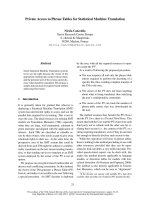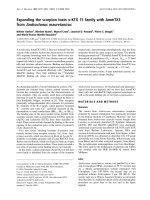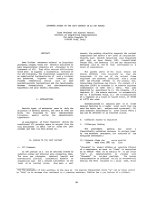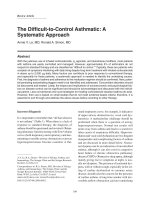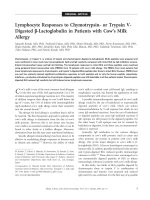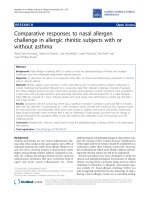Báo cáo y học: "Expanding access to HIV prevention" doc
Bạn đang xem bản rút gọn của tài liệu. Xem và tải ngay bản đầy đủ của tài liệu tại đây (196.99 KB, 3 trang )
BioMed Central
Page 1 of 3
(page number not for citation purposes)
AIDS Research and Therapy
Open Access
Short report
Expanding access to HIV prevention
Helene D Gayle*
Address: Director, HIV, TB, and Reproductive Health, Bill & Melinda Gates Foundation
Email: Helene D Gayle* -
* Corresponding author
Background
The expanding HIV/AIDS epidemic represents one of the
greatest threats to human health and international devel-
opment today, and strengthening the global response is
imperative. Despite recent progress in expanding access to
HIV/AIDS treatment [1], the world continues to severely
under-invest in efforts to fight HIV/AIDS, missing a tre-
mendous opportunity to change the course of the epi-
demic by bringing proven treatment and prevention
interventions to scale.
Nowhere is the need for an expanded response more
apparent – and the potential impact greater – than in
efforts to prevent the spread of new infections. In 2005
alone, nearly 5 million people worldwide became
infected with HIV, and today more than 40 million peo-
ple are living with HIV, more than in any previous year
[2]. Although extensive studies have shown the effective-
ness of numerous strategies for preventing the transmis-
sion of HIV [3], new infections continue to occur at
alarming rates because proven tools are not being used.
Fewer than one in five people at high risk for HIV have
access to effective prevention [4], and funding for preven-
tion programs is woefully inadequate [5]. There is also an
urgent need to increase research funding and accelerate
the development of new technologies for HIV prevention
[6].
By bringing new and more focused attention to preven-
tion, the world can slow, and ultimately reverse, the
spread of HIV. An analysis in 2002 by the World Health
Organization and UNAIDS found that expanded access to
existing prevention strategies could avert up to two-thirds
of the 45 million HIV infections projected to occur
between 2002 and 2010 [7], and a study in early 2005
affirmed that expanded access to these tools could stop
roughly half of infections by 2020 [8]. Still more infec-
tions could be prevented by the development and intro-
duction of new tools currently being evaluated, such as
topical microbicides, new treatments for other sexually
transmitted diseases, male circumcision, female dia-
phragms, and the best long-term hope, a preventive vac-
cine.
Expanded access to prevention is also critical for sustain-
ing the important progress being made in providing
antiretroviral therapy to people living with HIV. Unless
the rate of new infections is sharply curtailed, treatment
will never be able to keep pace with the growing need. For
example, while the World Health Organization's recent "3
by 5" campaign sought to provide antiretroviral treatment
to 3 million people by 2005, 5 million people became
newly infected this year alone.
To help accelerate HIV prevention access and research, the
Bill & Melinda Gates Foundation's Global Health pro-
gram has committed approximately $1.1 billion in grants
for HIV/AIDS programs since 1998 [9]. HIV/AIDS is
among the priority diseases and health conditions
addressed by the foundation, which provides support to
organizations worldwide to address health problems that
cause the greatest illness and death in developing coun-
tries, yet receive far too little attention and resources. The
remainder of this article describes the foundation's HIV/
AIDS grantmaking priorities, which focus on two critical
areas: first, maximizing use of currently available preven-
Published: 17 January 2006
AIDS Research and Therapy 2006, 3:2 doi:10.1186/1742-6405-3-2
Received: 13 December 2005
Accepted: 17 January 2006
This article is available from: />© 2006 Gayle; licensee BioMed Central Ltd.
This is an Open Access article distributed under the terms of the Creative Commons Attribution License ( />),
which permits unrestricted use, distribution, and reproduction in any medium, provided the original work is properly cited.
AIDS Research and Therapy 2006, 3:2 />Page 2 of 3
(page number not for citation purposes)
tion tools and integrating them with treatment and care;
and second, accelerating research on new prevention
tools.
Maximizing available tools
A top priority for the foundation is expanding access to
proven HIV prevention strategies for those who need
them most. In Botswana, where an estimated 35% of the
adult population is living with HIV infection [10], the
foundation is partnering with the national government
and Merck & Co., Inc., to bring a comprehensive preven-
tion and treatment response to national scale. In India,
the foundation's $200 million Avahan initiative aims to
expand access to HIV prevention programs for the most
vulnerable populations, including sex workers, their cli-
ents, injection drug users, and migrant workers. Avahan
works in partnership with national and local governments
and NGOs, and every month reaches tens of thousands of
people in six high-prevalence states and along the most-
traveled highways.
The foundation's programs to expand access to HIV pre-
vention are large-scale demonstration projects designed to
show what is possible and catalyze others to provide sup-
port. Our resources, though significant, are not great
enough to solve countries' HIV/AIDS challenges, and sus-
taining access to health services must ultimately be the
primary responsibility of the public sector. For example,
the foundation's contribution of $150 million to the Glo-
bal Fund to Fight AIDS, Tuberculosis, and Malaria – which
is assisting 128 countries in scaling up national responses
to HIV/AIDS and other leading infectious diseases – was
intended to help the fund get started and attract other
donors.
As HIV prevention programs are scaled up, it is essential
that they make use of the full range of available preven-
tion options, and that prevention programs are closely
integrated with treatment services. The foundation is a co-
convener of the Global HIV Prevention Working Group,
an international body of HIV/AIDS experts focused on
HIV prevention analysis and advocacy. In 2004, the Work-
ing Group released HIV Prevention in the Era of Expanded
Treatment Access, the first report to identify the benefits
and challenges to effective prevention posed by expand-
ing treatment access. (See esfounda
tion.org/GlobalHealth/Pri_Diseases/HIVAIDS/HIVPro-
gramsPartnerships/Prevention_Working_Group.htm.)
Accelerating research on new tools
While today's tools have been proven effective, there is no
"magic bullet" for HIV prevention. Women, in particular,
need far greater options to protect themselves from infec-
tion. The foundation has committed substantial funds to
research new prevention technologies that could have a
substantial impact on reducing new HIV infections,
including many that could be initiated by women. The
foundation provides grants to support basic research and
clinical trials of investigational HIV prevention technolo-
gies, some of which could be available within the next few
years:
Microbicides
Microbicides are topical gels or creams designed to be
applied to the vagina or rectum to prevent HIV infection.
The foundation has made grants to support a variety of
research and development efforts for microbicides,
including support for a large-scale efficacy trial of a lead-
ing microbicide candidate.
Herpes treatment for HIV prevention
Like many other sexually transmitted diseases, herpes
(HSV-2) infection significantly increases the risk of HIV
transmission. The foundation is supporting clinical
research to assess whether using the inexpensive drug acy-
clovir to treat HSV-2 reduces the risk of HIV acquisition
and transmission.
Diaphragms
Most HIV infections in women are believed to occur in the
cervix and endocervix. By covering the cervix, the female
diaphragm may provide protection against HIV infection.
The foundation has provided grants to support studies to
help assess diaphragms for HIV prevention in developing
countries.
Male circumcision
Results from an initial clinical trial in South Africa suggest
that male circumcision reduces the likelihood of female-
to-male sexual HIV transmission by 60% [11]. In order to
confirm these results, the foundation is supporting a trial
in Uganda, which is designed to determine if male circum-
cision also reduces the risk of male-to-female HIV trans-
mission.
Pre-exposure prophylaxis with antiretrovirals
Researchers are evaluating the drug tenofovir – a nucle-
otide reverse transcriptase inhibitor currently approved
for the treatment of HIV – in high-risk, HIV-negative indi-
viduals to prevent HIV infection. Tenofovir is adminis-
tered in pill form and is long lasting, slow to generate
resistance, and has relatively few side effects. The founda-
tion has provided support for international trials of teno-
fovir for HIV prevention.
Vaccines
A preventive HIV vaccine represents the greatest long-term
hope for reversing the epidemic, but research progress has
been slow. The foundation has contributed $126 million
toward research on promising approaches to HIV vaccina-
Publish with BioMed Central and every
scientist can read your work free of charge
"BioMed Central will be the most significant development for
disseminating the results of biomedical research in our lifetime."
Sir Paul Nurse, Cancer Research UK
Your research papers will be:
available free of charge to the entire biomedical community
peer reviewed and published immediately upon acceptance
cited in PubMed and archived on PubMed Central
yours — you keep the copyright
Submit your manuscript here:
/>BioMedcentral
AIDS Research and Therapy 2006, 3:2 />Page 3 of 3
(page number not for citation purposes)
tion. In addition, the foundation has joined with leading
research agencies and other funders to form the Global
HIV Vaccine Enterprise, a cooperative alliance that aims to
accelerate HIV vaccine development through greater col-
laboration, strategic focus, and resources. Future grant-
making by the foundation in the vaccine field will be
guided by the priorities identified in the Vaccine Enter-
prise's scientific strategic plan [12].
Conclusion
The Millennium Development Goals (MDGs) recognize
the toll that HIV is taking on individuals and societies, as
well as the central role that the fight against HIV/AIDS
plays in broader efforts to promote human health and
international development. History is counting on all of
us to realize that the relentless expansion of HIV is not
inevitable, and that a focused, concerted response can
save millions of lives.
References
1. WHO/UNAIDS: Progress on Global Access to HIV Antiretroviral Therapy:
An Update on "3 by 5," 2005 .
2. UNAIDS/WHO: AIDS Epidemic Update 2005.
3. Auerbach J, Coates T: HIV prevention research: accomplish-
ments and challenges for the third decade of AIDS. Am J Public
Health 2000, 90:1029-32.
4. USAID, et al.: Coverage of Selected Services for HIV/AIDS Prevention, Care,
and Support in Low- and Middle-Income Countries in 2003 2004.
5. UNAIDS: Resource Needs for an Expanded Response to AIDS in Low- and
Middle-Income Countries 2005.
6. UNAIDS: Financing the Expanded Response to AIDS: HIV Vaccine and
Microbicide Research and Development 2005.
7. Stover J, et al.: Can we reverse the HIV/AIDS pandemic with
an expanded response? Lancet 2002, 360:73-7.
8. Salomon J, et al.: Integrating HIV prevention and treatment:
from slogans to impact. PLoS Med 2005, 2:e16.
9. This figure includes grants specifically for HIV/AIDS, and
grants for multiple health conditions, including HIV/AIDS. .
10. UNAIDS/WHO: Report on the Global AIDS Epidemic 2004.
11. Auvert B, et al.: Randomized, controlled intervention trial of
male circumcision for reduction of HIV infection risk: the
ANRS 1265 trial. PloS Med 2005, 2:e298.
12. Coordinating Committee of the Global HIV Vaccine Enterprise: The
Global HIV Vaccine Enterprise: scientific strategic plan. PLoS
Med 2005, 2:e25.
